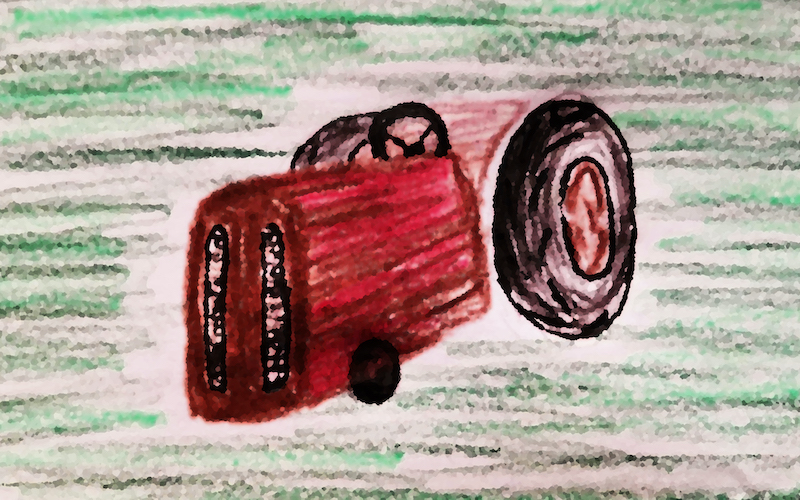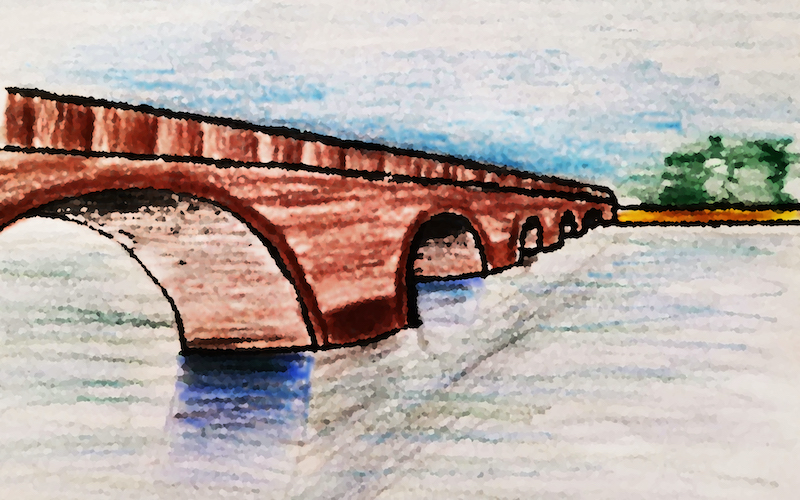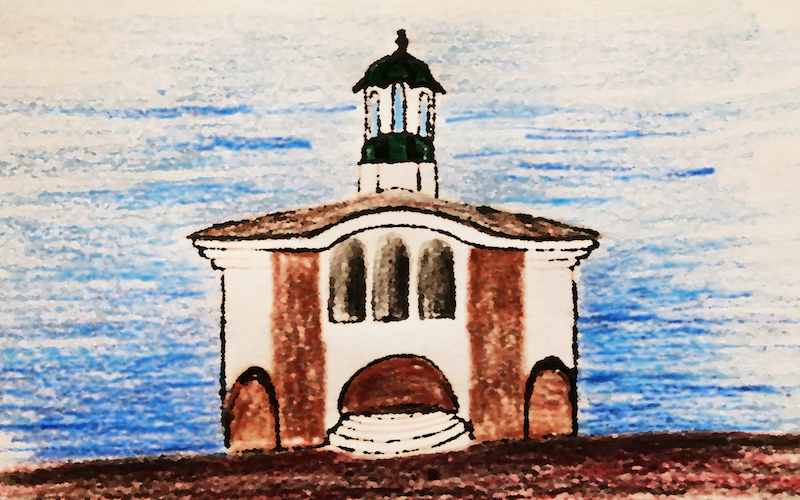The first part of this story can be found here: “Something about Sofia”
With no less than five of Gigi’s suitcases, we bundled into the black S-Class early one July morning. As the sun rose we ventured south.
“That’s my school,” Maria pointed to the vast Anglo-American campus in the distance. With her Swedish passport, she didn’t seem to see herself as half-Bulgarian. Her mother, on the other hand, was the archetype Bulgarian matriarch.
“What about the Bulgarian schools?” I inquired.
“They’re okay — they’re good for maths and computers . . . But that’s it.” Maria paused, before adding “Did you know a Bulgarian invented the computer?”
In the distance, clusters of depressed high-rises marked the periphery.
“The by-product of rapid expansion . . . Sofia’s population tripled under communism.” Gigi explained, “Entire suburbs emerged like weeds after the summer rain.”
Meanwhile, the asphalt artery ran through wasteland punctuated by abandoned factories. Silage stood in empty fields and Soviet-era tractors rusted in the grass.
“An apt metaphor for the Bulgarian economy,” I wondered.
“We were shut in for 40 years” Toshko explained, “We managed ok until we lost Yugoslavia . . . It killed our economy.”

We exchanged the highway for potholed backroads as we passed through Balkan hill villages towards the Rila, Pirin, and Rhodope mountains. Beside the road, carts laden with watermelons tottered past terracotta-tiled homes, where peppers dried on the terraces. Turning off from the Struma valley into the wilder country, Mount Musala — the Kiss of God — slipped into view. In the distance, eagles soared above the dark spruce forest. Meanwhile, the mountain switchbacks seemed to bring out the worst in the locals; I watched in disbelief as they engaged in hare-brained maneuvers on the hairpin bends. Reading my thoughts, Nils finally spoke:
“After a while you get used to it. Bulgarians made peace with their chaos long ago.”
Bedlam is in their blood and when impulsive Bulgarians get behind the wheel standby for a harem-scarem helter-skelter mix of highspeed ballet. Equal parts maddening and mesmerizing.
“I’ve got things to do but, if you insist, I’ll come with you,” Toshko said.
Maria’s Grandfather was accompanying us on our cross country soirée. In true Bulgarian fashion he had not asked, but rather subtly hinted, over the course of several months, at his desire to accompany us.
“Bulgarians will never ask for anything directly,” Nils confirmed, “they would rather beat around the bush until they are offered it.”
It was mid-morning when we arrived at Rila.
“In the 10th century a royal courtier sought a life of solitude here,” Katya, our lively tour guide, explained, “Over time disciples joined Ivan of Rila, and a community developed that eventually became the monastery.”
Rila is a mythical city in the clouds. Her four wings are enclosed by great portico balconies that overlook the vast cobbled courtyard. The Monastery’s arches, towers and domes, are decorated with the same monochrome stripes.
“In each cell there is a monk.” Katya pointed to a balcony carved into the rock, “There are over 300 individual cells.”
Inside the Church of the Dormition, enthralling frescoes depict 1,200 different scenes from Scripture.
“The iconostasis is the finest in all the Balkans.” Katya added, as pilgrims and tourists alike stood mesmerised. Nearby, bearded monks filed past in silence, dressed head to toe in black.
One of the wings houses a museum that contains a 10th-century stone cross painstakingly carved by a monk named Raphael.
“It took 12 years to carve — can you believe it.” Gigi read from the accompanying sign.
“A fire ravaged the monastery in 1335, but Rila was rebuilt by a Lord named Khrelio. He added the keep and chapel we see today,” Katya informed us. “Under the Ottomans, Rila was the beating heart of the Balkans. It linked Bulgaria to Constantinople, Athos, and Ohrid.”
After a late lunch of grilled meats and ‘shopska salad’ — succulent tomatoes and cucumbers, laden with crumbly white cheese — we doubled back towards Sofia, before taking the highway east. Gigi was digging around in the glove box for some music and U2’s Greatest Hits was the soundtrack for our long drive east. But as we motored across Bulgaria in comfort, I half envied Paddy Fermor’s long walk in the region, 80 years earlier.
“Where is the real Bulgaria?” I wondered.
The miles rolled by as we reached deeper into the Bulgarian backwaters. Further out, lonely figures hoed fields and mended fences, plumes of smoke rose from pyres. Beside us, donkey carts straddled the ancient road travelled by Thracians, Romans, Khazars, Byzantines, Tatars, and Turks.
“How do you like Bulgaria?” Nils made eye contact in the rear-view mirror.
“Yes there’s a lot to like — you’ve certainly found a good life here,” but I though briefly of the miserable poor, foraging through bins of begging at the junctions.
“It’s a great place to be an expat.” Nils confirmed.
•
Equidistant between the Adriatic and Black Seas, Mirkovo village lies in the Pirdop valley beneath Etropolska, 40 miles east of Sofia. The red and yellow St Demetrius’s Church stands in the center of simple timber-framed homes with faded terracotta tiles. During the National Revival period, the intrepid locals formed Hajduk resistance networks to assist the Russians against the Turkish. Mirkovo was home to the modest summer residence of Dani — a childhood friend of Gigi — and her unintentionally hilarious husband, Gotcho. Their daughter Katiya — one of Maria’s closest friends — was there too. The traditional village and courtyard looked like an overgrown building site.
“It’s got electricity, but not running water,” Nils laughed.
The three of us had visited Sofia Zoo together the previous month and the witty, charismatic Katya was great company. The evenings together drinking Rakia and coke in the garden of their dilapidated home were some of the most enjoyable of the summer.
Getting any sleep was a different matter. There was no glass in the windows, and the medieval straw mattress I found myself upon was bug infested. The one acceptable bedroom, it transpired, had been reserved for Toshko. Lazy days passed in shade, listing to Melody FM — Bulgaria’s hit radio station — while Gotcho cooked Chicken on an electric grill, running precariously from an extension lead into the garden.
Dani was twice the size of her husband and ever the unashamedly dominant Bulgarian matriarch.
“The man may be the head . . . but the woman is the neck.” Didi muttered.
Gotcho was a comedy spectacle who embodied a Marx brother kind of buffoonery. Back in Sofia I once helped him deliver a roll of carpet up a flight of stairs. The apex of Bulgarian culture consists of dining to excess whilst trash talking their neighbours. It was not unusual for meals to last six or seven hours.
“Our record is 12 hours.” Maria laughed.
Giga was always the life of the conversation and “Can you believe it” was her catch phrase. She read aloud a crazy news article.
“Gypsies tied a dog to a car and dragged it until it died!” or “Roma broke a man’s head in Apriltsi; they set him on fire as to remove evidence.”
Gocho was an ex-fireman who owned a Colt 45.
“From his time in the Bulgarian fire service” Dani confirmed.
“Exactly why did a fireman need a gun?” I wondered.
Nevertheless, it made an appearance later that night and between shots of Rakia we took turns blasting bottles in the garden.
In Bulgarian culture, the full spectrum of emotions can be manifest in a single conversation. So loud is the conversation, so coarse the tone, “Two women make a whole market.” The brightness was nauseating and, crouched over their toilet, I vomited up the last of my Kebapche. This was no Rakia induced discharge — it was heatstroke and I retired upstairs to sleep it off. However, I was awoken within the hours to the sound of a slaughterhouse downstairs. When I plucked up the courage to investigate the blood-curdling screeching, Gigi and Dani, Katiya and Maria were rolling around on the sofa shrieking hysterically. The next morning no one, it transpired, had had much sleep. Not to worry, Gigi casually measured out three spoons of instant coffee and mixed with coke, blended into a frothing cardiac-arrhythmia-inducing concoction. Buzzing from our sucker punch of a wake-up, we bid farewell to Katya and her crazy parents, as we re-joined the highway.
•
Our road trip followed the horizontal artery east through the valley of the Thracian kings, to the recently excavated 500 BC necropolis. Nils decelerated and a short while later we reached the brutalist concrete facade of the Iskra History Museum.
“They found a 1 lb solid-gold funeral mask,” Toshko informed us.
“Whose weight dwarfed Agamemnon’s Mycenaean Mask,” Bulgarians proudly add.
Then there was the 26 lb bronze severed head from Seuthopolis, built by King Seuthes III, leader of the Odryssian Thracians, who participated in King Sitalkes’s Great March into Macedonia.
“They found a 60 ton sarcophagus carved from a single granite slab.”
“It contained an obscene amount of gold artifacts . . . but most were looted.” Gigi glibly announced.
Bulgarians love to boast about their cultural richness but, at any museum you; will invariably find them outside in the shade, tucking into a midmorning ice cream.

The road accompanied the Maritsa River into the heart of ancient Thrace, as the fertile valley gave way to rolling plains and hillsides scarred by the ancient gold mines. Thracian cosmology begins with the Great Mother Goddess, who self-conceived the Sun. Together they bore the Thracian King, who in life attained divinity and in death was worshiped.
“The Thracian creation story explains how we women can be so dominant.” Maria laughed.
The King was buried with all his earthly possessions; necessary provisions for the next leg of his journey. Even today, the image of the rider – the bearer of Thracian immortality — is painted upon rocks and hammered into jewellery.
The Persians invaded and the Greeks colonised their shores, but the resilient Thracians — united under the Odrysian kingdom – fought back from their mountain strongholds. Rhoemetalces III, the last Odrysian King, was murdered in a coup led by his wife. Mariticide curtailed the Odrysian dynasty and Thrace was incorporated into the Roman Empire by Tiberius.
“Not much has changed” Nils chuckled, “Bulgarian women are still committed to undermining their husbands.”
Bulgarians will inform you that they are descended from noble Thracian stock. But anthropologists trace the origin of proto-Bulgars to the plains of present-day northern Afghanistan, where they belonged to illiterate, Indo-European tribes, who settled in the 7th century AD and mixed with the Slavic lower-classes. Yet modern Bulgarians cleave to the Thracian fantasy to mask the cancerous abscesses of Ottoman and Russian subjugation, preferring to remember themselves as Trojan allies, skillful riders, and formidable fighters.
The following day we reached Kazanluk — a nondescript town stride two river valleys; the Stryama to the west and the Tundzha to the east. By late-July, the rose harvest was in full swing and the sweet aroma of Damascene filled the valley. From dawn until noon women cut the delicate stems by hand into their willow-baskets. Nils made a call to an old friend — Radion, a former government minister — who had retired to the region.
“One liter of rose oil requires 3500 kilos of rose blossom,” Radion announced as we toured his quaint distillery.
“Rose oil is one of Bulgaria’s lesser-known commodities,” Nils added, for my benefit.
“It’s big in China — my wife has just returned from an expo over there.” Radion was enthusiastic. “And the rose water is popular in Dubai.”
“They have high hopes, but I’d be surprised if it ever materializes.” Nils confided once we were out of earshot, “the Bulgarian mentality will get in the way.”
•
The following day we arrived in Gabrovo, a city whose citizens are renowned for their quick wit. To an outsider, Bulgarian humour is drier than homemade Rakia. There is no light at the end of their joke, no semblance of solace in their mirth. Searching for their punchline, one locates only the Bulgarian race, themselves. The Gabrovtsi wit is a self-denigrating ode to their stinginess.
“The legendary Gabrovian “Old Minyo” carried his shoes on long walks, and sat in the dark to preserve his candle wax.” Toshko explained over dinner. “And yet, his frugal feats are celebrated because they enabled his famous generosity.”

“Why do Gabrovtsi flash the lamp on and off when they’re reading a book? To save energy while turning pages.” Gigi began, “A Gabrovtsi bought a car. He didn’t pay the whole price upfront but kept back a small amount. After some days, the seller received the car’s horn with the following note: “I give you the horn back, because after some rehearsals my wife learned to whistle like it. Deduct its value from the amount due. Close the account.”
After a dinner of Kebapche and fried zucchini topped with white cheese, we huddled around Maria’s laptop to watch Mission London, a tragi-comedy set in London’s Bulgarian Embassy. There and then, I began to understand the mentality that everyone referred to.
Gabrovo is home to the Museum House of Humour and Satire; it was intended to showcase the arts under Communism. The organizers could not have grasped the irony of their endeavour.
Of course, art relies upon individual expression, something the Communists vehemently suppressed. While the party leaders lived like princes, the population survived the tyranny with humor. Communist-era jokes lambast the regimes dunderheaded buffoonery yet nevertheless acknowledge its deity-lie domination.
“Artists, banned from exhibiting their ordinary work, would submit pieces of realism with an ironic twist.”
The museum was closed, but that didn’t stop Toshko telling us about it. “Humor was a coping mechanism for the hypocrisies of Communism. When language was controlled, reality became one absurd joke.”
“Don’t try and understand the sort of mind that conceives of a museum of comedy,” Nils reflected.
With that we left the tragic Gabrovians to their business and headed towards our next stop — Toshko’s ancestral village.
•
“We were thunder-worshipping Turkic nomads, we roamed the steppes on horseback.” Toshko embarked upon a spirited lecture.
“Driving cattle and pillaging our neighbors.”
“The landed equivalent to Vikings.” Nils chipped in.
“Fierce warriors, we even defeated the Byzantine empire.” Toshko continued.
“But you could never cooperate?”
“Khan Kubrat was a wise king. He was educated in Constantinople alongside the future Byzantine emperor Heraclius. The two became friends, and Kubrat was baptised. Kubrat united the Bulgar tribes and established Old Great Bulgaria on the north shores of the Black Sea.”
“A most well-mannered, cultured Bulgarian.”
“The Khazars attacked from the east and captured Phanagoria up to the Black Seam, but Kubrat repelled them”
“According to legend, Kubrat challenged each of his five sons to prove their strength and break a bundle of vines. But all five sons failed. Then Kubrat separated the bunch and broke each individually, to demonstrate that ‘Unity Yields Strength.’”
“United, Bulgarians can lift a mountain.” Toshko smiled.
The Khazars invaded again, but the brothers forgot their Father’s lesson and scattered. Bulgarians are historically uncooperative and stubborn, and even Herodotus laments their inability to unify and consolidate power.
Asparukh, the third son of Kubrat, crossed the Danube to invade the fertile Moesia plains, where he defeated the Byzantine emperor Constantine IV. Then, united with the seven Slavonic tribes of Moesia, Asparukh invaded Thrace, sparking another war with Byzantium.
The Bulgarian backwaters conjure romantic notions of the Balkans and, history lesson over; we pulled up in Toshko’s ancestral village. Golets was a forgotten corner of Bulgaria, down a dusty track coming off the highway. The family returned occasionally to reminisce in the sleepy village in Ugarchin Municipality. Simple plaster homes were arranged around the Church, their faded gates opened onto pastures and courtyards of flowers. The TV News hummed and herbs wafted from soot-coated kitchens. Purple grapes hung from trellises, and underneath, dogs slept in the shadows as hens scratched at straw. Anniversary signs commemorated the faithful, reminding the living to prayer for the souls of their dearly departed. The young families had long since migrated to the city and a village with no future was gracefully dying.
Elderly neighbors greeted Toshko; second and third cousins crept from the woodwork of their simple life. The property was hopelessly overgrown, the wooden beams partially collapsed under the roof. I could make out a manor and a walled garden. Maria pointed to a distant forest, beyond a stream.
“That’s where he fought the Commies . . . Toshko was badass!” she giggled.
Golets disappeared as we pulled back on to the highway and travelled deeper into Bulgaria’s beating heart. •
This is a work of creative nonfiction. Names have been changed and some creative choices have been made for the purpose of the narrative.




